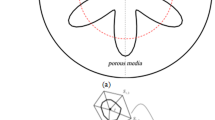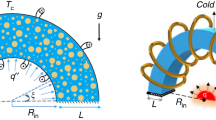Abstract
In current investigation, ferrofluid circulation and energy transport inside a wavy-walled porous enclosure are modeled considering radiation and EHD effects. The finite volume method is employing for simulation of EHD circulation structures and thermal transmission. Properties of working fluid depend on the electric field and nanosized solid particles concentration. Impacts of thermal radiation, nanoparticles shape, and volume fraction are considered in governing equations. Distributions of unknown functions are received for various voltage, permeability, radiation parameters, nanoparticles’ shape and concentration. Results have shown that platelet form leads to the strongest convective circulation. An amplification of electric force characterizes a diminution of the boundary layer thickness. Greater permeability of the porous medium characterizes the strongest convective circulation and thermal transmission.









Similar content being viewed by others
References
Shenoy A, Sheremet M, Pop I. Convective flow and heat transfer from wavy surfaces: viscous fluids, porous media and nanofluids. Boca Raton: CRC Press; 2016.
Sheikholeslami M, Shamlooei M. Convective flow of nanofluid inside a lid driven porous cavity using CVFEM. Physica B Condens Matter. 2017;521:239–50.
Sheikholeslami M, Shehzad SA. Magnetohydrodynamic nanofluid convective flow in a porous enclosure by means of LBM. Int J Heat Mass Transf. 2017;113:796–805.
Astanina MS, Sheremet MA, Umavathi JC. Transient natural convection with temperature-dependent viscosity in a square partially porous cavity having a heat-generating source. Numer Heat Transf A. 2018;73:849–62.
Sheikholeslami M, Li Z, Shamlooei M. Nanofluid MHD natural convection through a porous complex shaped cavity considering thermal radiation. Phys Lett A. 2018;382:1615–32.
Sheikholeslami M, Chamkha AJ. Flow and convective heat transfer of a ferro-nanofluid in a double-sided lid-driven cavity with a wavy wall in the presence of a variable magnetic field. Numer Heat Transf A. 2016;69:1186–200.
Alsabery AI, Sheremet MA, Chamkha AJ, Hashim I. Impact of nonhomogeneous nanofluid model on transient mixed convection in a double lid-driven wavy cavity involving solid circular cylinder. Int J Mech Sci. 2019;150:637–55.
Mehryan SAM, Kashkooli FM, Ghalambaz M, Chamkha AJ. Free convection of hybrid Al2O3–Cu water nanofluid in a differentially heated porous cavity. Adv Powder Technol. 2017;28:2295–305.
Ho CJ, Chiou YH, Yan WM, Ghalambaz M. Transient cooling characteristics of Al2O3-water nanofluid flow in a microchannel subject to a sudden-pulsed heat flux. Int J Mech Sci. 2019;151:95–105.
Miroshnichenko IV, Sheremet MA, Oztop HF, Abu-Hamdeh N. Natural convection of alumina-water nanofluid in an open cavity having multiple porous layers. Int J Heat Mass Transf. 2018;125:648–57.
Khanafer K, Vafai K. Applications of nanofluids in porous medium. A critical review. J Therm Anal Calorim. 2019;135:1479–92.
Alsabery AI, Tayebi T, Chamkha AJ, Hashim I. Effect of rotating solid cylinder on entropy generation and convective heat transfer in a wavy porous cavity heated from below. Int Commun Heat Mass Transf. 2018;95:197–209.
Sheikholeslami M, Jafaryar M, Shafee A, Li Z, Haq R. Heat transfer of nanoparticles employing innovative turbulator considering entropy generation. Int J Heat Mass Transf. 2019;136:1233–40.
Ashorynejad HR, Shahriari A. MHD natural convection of hybrid nanofluid in an open wavy cavity. Results Phys. 2018;9:440–55.
Pal SK, Bhattacharyya S, Pop I. Effect of solid-to-fluid conductivity ratio on mixed convection and entropy generation of a nanofluid in a lid-driven enclosure with a thick wavy wall. Int J Heat Mass Transf. 2018;127:885–900.
Qi C, Zhao N, Cui X, Chen T, Hu J. Effects of half spherical bulges on heat transfer characteristics of CPU cooled by TiO2-water nanofluids. Int J Heat Mass Transf. 2018;123:320–30.
Sheikholeslami M, Haq R, Shafee A, Li Z. Heat transfer behavior of nanoparticle enhanced PCM solidification through an enclosure with V shaped fins. Int J Heat Mass Transf. 2019;130:1322–42.
Alsabery AI, Mohebbi R, Chamkha AJ, Hashim I. Effect of local thermal non-equilibrium model on natural convection in a nanofluid-filled wavy-walled porous cavity containing inner solid cylinder. Chem Eng Sci. 2019;201:247–63.
Ahmed SE, Rashed ZZ. MHD natural convection in a heat generating porous medium-filled wavy enclosures using Buongiorno’s nanofluid model. Case Stud Therm Eng. 2019;14:100430.
Ebrahimi-Moghadam A, Moghadam AJ. Optimal design of geometrical parameters and flow characteristics for Al2O3/water nanofluid inside corrugated heat exchangers by using entropy generation minimization and genetic algorithm methods. Appl Therm Eng. 2019;149:889–98.
Sheikholeslami M. New computational approach for exergy and entropy analysis of nanofluid under the impact of Lorentz force through a porous media. Comput Methods Appl Mech Eng. 2019;344:319–33.
Izadi S, Armaghani T, Ghasemiasl R, Chamkha AJ, Molana M. A comprehensive review on mixed convection of nanofluids in various shapes of enclosures. Powder Technol. 2019;343:880–907.
Hoghoughi G, Izadi M, Oztop HF, Abu-Hamdeh N. Effect of geometrical parameters on natural convection in a porous undulant-wall enclosure saturated by a nanofluid using Buongiorno’s model. J Mol Liq. 2018;255:148–59.
Buongiorno J. Convective transport in nanofluids. J Heat Transf. 2006;128:240–50.
Javed T, Mehmood Z, Abbas Z. Natural convection in square cavity filled with ferrofluid saturated porous medium in the presence of uniform magnetic field. Physica B Condens Matter. 2017;506:122–32.
Mahanthesh B, Gireesha BJ, Shehzad SA, Rauf A, Sampathkumar PB. Nonlinear radiated MHD flow of nanoliquids due to a rotating disk with irregular heat source and heat flux condition. Physica B Condens Matter. 2018;537:98–104.
Shahriari A, Ashorynejad HR, Pop I. Entropy generation of MHD nanofluid inside an inclined wavy cavity by lattice Boltzmann method. J Therm Anal Calorim. 2019;135:283–303.
Bellos E, Tzivanidis C. A review of concentrating solar thermal collectors with and without nanofluids. J Therm Anal Calorim. 2019;135:763–86.
Qureshi MZA, Ashraf M. Computational analysis of nanofluids: a review. Eur Phys J Plus. 2018;133:1–22.
Mahian O, Kolsi L, Amani M, Estelle P, Ahmadi G, Kleinstreuer C, Marshall JS, Siavashi M, Taylor RA, Niazmand H, Wongwises S, Hayat T, Kolanjiyil A, Kasaeian A, Pop I. Recent advances in modeling and simulation of nanofluid flows—Part I: fundamentals and theory. Phys Rep. 2019;790:1–48.
Mahian O, Kolsi L, Amani M, Estelle P, Ahmadi G, Kleinstreuer C, Marshall JS, Taylor RA, Abu-Nada E, Rashidi S, Niazmand H, Wongwises S, Hayat T, Kasaeian A, Pop I. Recent advances in modeling and simulation of nanofluid flows—Part II: applications. Phys Rep. 2019;791:1–59.
Sheikholeslami M. Application of control volume based finite element method (CVFEM) for nanofluid flow and heat transfer. Amsterdam: Elsevier; 2019 ISBN: 9780128141526.
Moallemi MK, Jang KS. Prandtl number effects on laminar mixed convection heat transfer in a lid-driven cavity. Int J Heat Mass Transf. 1992;35:1881–92.
Khanafer K, Vafai K, Lightstone M. Buoyancy-driven heat transfer enhancement in a two-dimensional enclosure utilizing nanofluids. Int J Heat Mass Transf. 2003;446:3639–53.
Acknowledgements
The second author acknowledges the financial support from the Ministry of Education and Science of the Russian Federation (Project No. 13.6542.2017/6.7). Authors also wish to express their thanks to the very competent Reviewers for the valuable comments and suggestions.
Author information
Authors and Affiliations
Corresponding author
Additional information
Publisher's Note
Springer Nature remains neutral with regard to jurisdictional claims in published maps and institutional affiliations.
Rights and permissions
About this article
Cite this article
Sheikholeslami, M., Sheremet, M.A., Shafee, A. et al. CVFEM approach for EHD flow of nanofluid through porous medium within a wavy chamber under the impacts of radiation and moving walls. J Therm Anal Calorim 138, 573–581 (2019). https://doi.org/10.1007/s10973-019-08235-3
Received:
Accepted:
Published:
Issue Date:
DOI: https://doi.org/10.1007/s10973-019-08235-3




